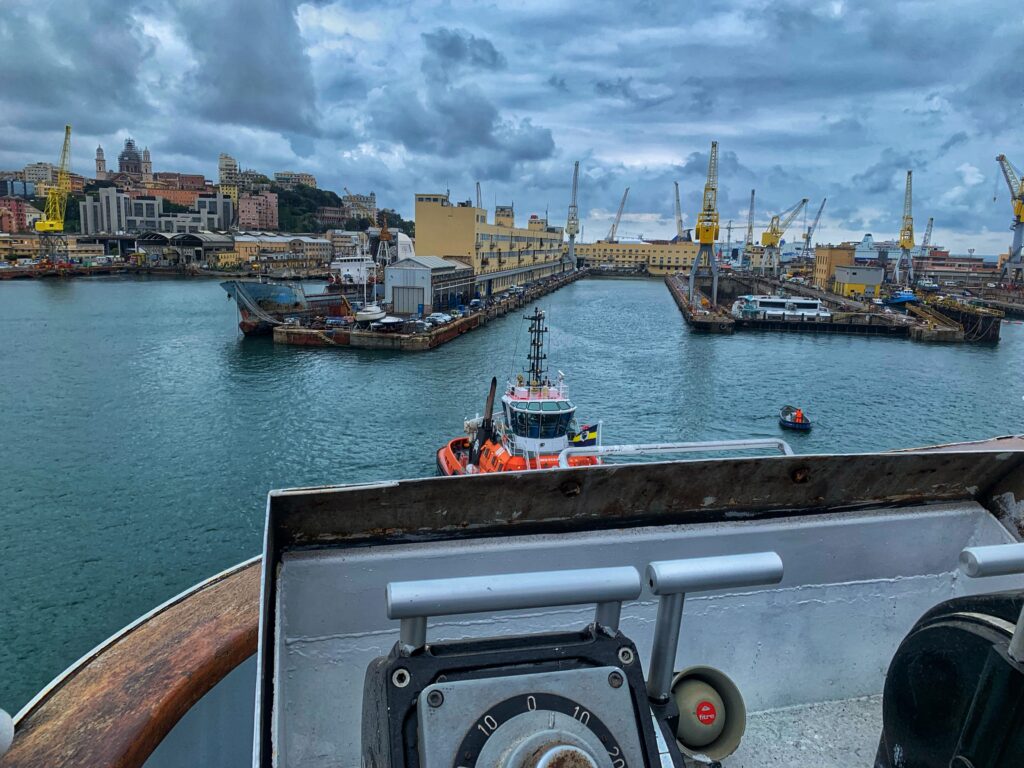Manoeuvre Nr. 3 – Entering Dry Dock

When a ship has to be taken to a dry dock, it is usually very “light”. Meaning that, compatibly with the immersion of the propeller and in compliance with the IMO stability criteria, she has as little ballast as possible. She is lighter than expected under normal ballast conditions. We must manoeuvre in confined spaces, sometimes with limitations in the use of propellers, winches and bow or stern thrusters. For this reason, we must pay special attention to local weather forecasts.
It is a delicate-precision operation.
An essential factor for planning dock entry is the availability or not of the ship’s propulsion system. Vessel size and dock dimension are the other two factors influencing the number of tugs we use. Generally, we start from at least one in the case of modest-sized ships, provided with the bow thruster and with every navigational aid in good working order, to five and more tugs in large vessels with functional limitations.
Basins are not all the same. The space available, any currents, and other local factors influence the strategies and make it impossible to generalize. Still, the following example’s considerations help us understand the correct approach to these manoeuvres.
Let’s consider this situation:
- Container vessel 222 metres long and 30 metres wide,
- Fixed-pitch propeller right-handed,
- In light ballast,
- With “out of order” bow thruster,
- The basin is 260 metres long and 37 metres wide,
- No wind and no current.
We must enter with the bow inside and stop the vessel 20 meters from the basin end.
The ship is not particularly wide, but the absence of the bow thruster and the basin size lead us to take precautions to manage the ship’s alignment and stopping.
The ship is 30 wide and the basin 37; if it entered the drydock, the fwd tug would not have the space to exit at the manoeuvre completion.
We decide to use three tugs. We will use one for speed and steering control and two for alignment control.
Phase 1
We give two ship’s lines – secured at each corner of the ship’s stern – to the aft tugboat. It allows us to control the ship’s stern rapidly; making fast the tugboat with only one cable in the centre would take too long for quick steering corrections; having to go from one side to the other leads to losing time.
We make fast one tugboat to the starboard and one to the port at the bow.
Phase 2
Once we have secured the tugs, we proceed at reduced speed – about 3/4 knots – approaching the dock entrance with the bow angled to port. So, the paddle-wheel effect should bring us closer to proper alignment when we reverse the engine astern to stop.
The tugs work at their minimum power to steer and stop the ship in the correct position.
Phase 3
Once everything is under control, we let go of the port tug forward, which passes the ship’s line to a mooring boat, then the fwd starboard one, which gives the second ship’s line to the second mooring boat.
Since the weather conditions are optimal, the choice is dictated only by the remote possibility of controlling the propeller’s right-handed effect until all lines are sent to the mooring boat.
Phase 4
The mooring men adjust and tighten the lines while, with engine kicks ahead, we recreate a situation of slight headway. It is necessary to adjust the lines’ length fine: the narrow basin and too long lines would not allow reasonable control on the direction, while too-short lines would limit the (already poor) mooring boat pulling power.
Phase 5
The stern tug corrects the alignment with small taps from one side or the other, while the two tugboats previously released shift near the dock entrance, ready to lean against the ship’s side when she approaches too close to the drydock entrance.
If necessary, we still use the engine’s kicks to maintain the slight headway needed while the mooring boats continue to pull forward by moving to the starboard or to the port to keep the ship’s bow in a central position.
Phase 6
When the ship’s bow reaches the middle of the basin, we can send the springs ashore. The mooring boats have to stop in time to not get too fast to the berth position. Then, we send the mooring lines ashore. In this final phase, the stern tug helps us gradually slow down the speed until we stop.
In fact, from the moment the ship’s stern crosses the dry dock’s gate, we can no longer use the engine because it could move the supporting blocks on which the vessel will rest once dried.
We’ll pass the aft springs and adjust the position with the ship stopped.
